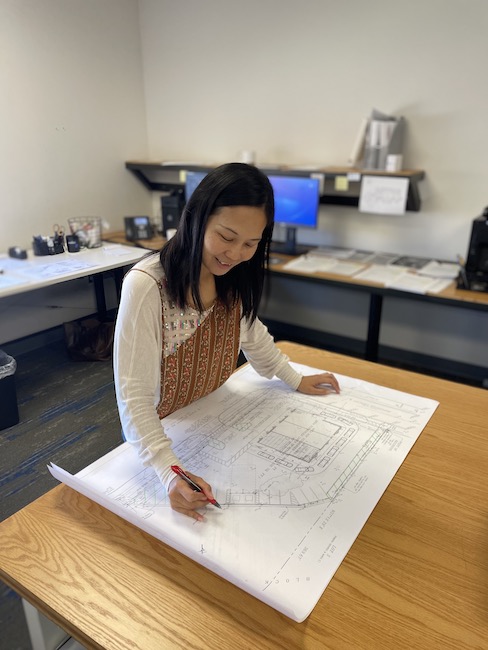From civil and structural engineering to surveying to roof consulting, there are a lot of specializations within the AEC industry that are often overlooked or that the general public knows very little about.
One of the goals of our blog is to bring you a behind-the-scenes look into some of the nuanced aspects of the AEC industry. Our “Drilling Down into AEC Specializations” series is designed to give those interested in AEC – especially students – a peek into Wallace Design Collective’s different consulting services and some of the specialized parts and pieces that tie architecture and construction together.
__________________________________________________________
Leaves are falling, and in this segment, we’re dropping down into landscape architecture with Nan Yuan, PLA. Nan followed her interests in design, sustainability, and the synergy between humans and nature, studying architecture and city planning before finding her true calling as a landscape architect. If there’s one thing she hopes to convey, it’s that landscape architecture isn’t just “gardening” or arranging trees and flowers – it’s about finding innovative ways to incorporate the natural world into everyday life to address big-picture, global issues. Whether it’s relieving stress through nature or combatting pollution and urban heat islands with green spaces, landscape architects are tackling some of today’s most pressing social, climatological, and environmental challenges through their passion and understanding of the natural world.
Read on for some of Nan’s insights into her favorite aspects of landscape architecture and advice for those who might be interested in getting into a landscape architecture career:
In your own words, how would you sum up the basics of what a landscape architect does and why it's important?
Landscape architecture is the study and practice of designing environments (outdoors & indoors) of varying scale that encompass elements of art, environment, architecture, engineering, and sociology. Specifically, landscape architects design attractive and functional public parks, gardens, playgrounds, residential areas, college campuses, and public spaces. They also plan the locations of buildings, roads, walkways, flowers, shrubs, and trees within these environments.
Landscape architects are using their work to tackle global issues such as sustainability, climate change, mental health, mosquito-borne disease, and poverty. Attractive and accessible landscapes invite and encourage physical activity. They can also provide an escape from the pace of modern life and give us insights into our past and culture. Engaging more closely with landscapes is thus good for our physical and mental health and well-being as individuals.
What drew you to landscape architecture? Alternatively, what's your favorite thing or the most fun/unique aspect of your job?
A good landscape architect is an engineer, visionary, communicator, designer, and ecologist. He or she is able to connect with the environment and determine, with the help of science and design, innovative ways of creating functional and practical spaces that inspire. The practice of protecting the environment, improving spaces for people, and making cities more liveable through innovative planning, green spaces, renewable energy, and green infrastructure is very attractive.
What type of project do you enjoy the most, or what's the most memorable/interesting project you've worked on?
I like outdoor public recreation projects the most. When you live in an urban area, public parks and outdoor spaces are the only natural retreat. For example, if you are living in New York, then the natural environment of Central Park offers regular respite from the concrete city. Similar open places in cities can be developed to create spaces where people can relax outside their homes. In cities with tighter spaces, pocket parks, elevated parks, etc. can be developed to achieve the same result. With greener patches, air in the cities can improve and boost the well-being of its inhabitants.
What misconceptions do you think other people have about what you do?
I find people think that landscape architects primarily select and arrange plants, or that landscape architects are gardeners.
How does where you are now compare to where you thought you would end up when you were in school? Any twists or turns that brought you here?
My background is in architecture, and my first master's degree is in city planning. I’m interested in the design field, but it took me several years to figure out what I really like. I’m more interested in setting a dynamic balance between human development and natural environments. So I transferred to the landscape architecture field after I worked as a city planner for several years. But my previous study and working experiences provided me with a very good base.
Your interests, skills, families, and experiences will affect your career plan from different aspects at different stages. Figure out what you really like and are really good at and make your decision based on your situation. You will get to the place you want to be.
What types of people do you think are well suited for landscape architecture?
Landscape architects tend to be predominantly artistic individuals, meaning that they are creative and original and work well in a setting that allows for self-expression. They also tend to be investigative, which means that they are quite inquisitive and curious people that often like to spend time alone with their thoughts.
There's nothing like real-world experience to bring some perspective. What advice would you give your college-self (or current students or individuals who might be considering this as a career)?
The knowledge and abilities you learned from school are a good starting point. Keep learning on your own and have good communication with your colleagues. Also, having some intern/working experiences on these items will help you to understand Landscape Architect career better.
Meet with clients, engineers, and building architects to understand the requirements of a projectPrepare site plans, specifications, and cost estimatesCoordinate the arrangement of existing and proposed land features and structuresPrepare graphic representations of plans using computer-aided design and drafting (CADD) softwareSelect appropriate landscaping materialsAnalyze environmental reports on land conditions, such as drainage and energy usageInspect landscape project progress to ensure that it adheres to plansSeek new work through marketing activities or by giving presentations
Are you a student who’s interested in architecture/engineering/construction (AEC) but not sure exactly what it entails, or which part of it might be right for you? Follow our series to get an in-depth look into structural and civil engineering, surveying, roof consulting, forensics, landscape architecture, and more from some of Wallace Design Collective’s top professionals.



There are no comments.